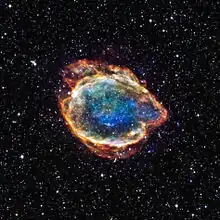Katzman Automatic Imaging Telescope
The Katzman Automatic Imaging Telescope (KAIT) is an automated telescope used in the search for supernovae.
 The Katzman Automatic Imaging Telescope dome | |
| Alternative names | KAIT |
|---|---|
| Part of | Lick Observatory |
| Location(s) | Santa Clara County, California |
| Coordinates | 37°20′36″N 121°38′05″W |
| First light | 1996 |
| Telescope style | optical telescope |
| Diameter | 76 cm (2 ft 6 in) |
| Website | www |
 Location of Katzman Automatic Imaging Telescope | |
The telescope had a first light in 1998, and is a noted robotic telescope.[1] It had first recorded data in August 1996, and was formally dedicated late that year.[2] It was used for the Lick Observatory Supernova Search.[3]
The KAIT is a computer-controlled reflecting telescope with a 76 cm mirror and a CCD camera to take pictures. It is located at the Lick Observatory near San Jose, California.
KAIT can take close to 100 images per hour and observe about 1000 galaxies a night.
The Katzman Automatic Imaging Telescope is a robotic telescope designed to look for supernova.[4] The telescope uses 76 cm (30 inch) diameter mirror that feeds a CCD imager with 20 slot filter wheel.[4] The telescope is also supported by an electronic weather station, that can feed data to the robotic telescope control system.[3] Several computers run software that controls the telescope and take in the data from the sensors.[3]
The telescope's development was funded by the NSF at private donors since 1989, turning 30-inch (~760 mm) telescope in a computer controlled super nova huntress.[5] The telescope can also monitor the brightness of variable stars.[5]
Observations & research
KAIT discovered its first supernova in 1997, SN 1997bs.[3] The next year (1998) twenty supernova were found after improvements to the telescope, and in 1999 forty supernova were discovered.[3]
The telescope has been noted for discovering the supernova SN 1999em.[6] This super nova was in the spiral galaxy NGC 1637, and was observed later by telescope such as the VLT (4x8.2m).[6]
Another example of KAIT discovery was SN 1999ec, a type Ib supernova that was discovered in the interacting galaxy NGC 2207 on October 2, 1999.[7]
In 2011, KAIT was one of six telescopes used for the Lick AGN Monitoring Project.[8]
Between 1998 and 2013, KAIT had discovered 900 supernova.[9] In 2013, the supernova 2013ej was discovered by KAIT in the galaxy Messier 74; it was noted for being as bright as 10th magnitude.[9]
In 2014, KAIT helped determine the age of a supernova found in the galaxy M83, because it had images of that region of the sky from just a few days prior to its discovery, establishing it had not brightened at that time.[10]
In 2016, KAIT spotted the super nova SN 2016coj in NGC 4125, thought to be a Type Ia supernova.[11]
In 2019, KAIT was one of the telescopes whose data was used in a study on Blazars.[12]
Discoveries[13]
| Year | Supernovae | Novae | Dwarf Novae | Comets |
|---|---|---|---|---|
| 1998 | 20 | 4 | 2 | 1 |
| 1999 | 40 | 1 | 7 | 1 |
| 2000 | 38 | 2 | 0 | 0 |
| 2001 | 68 | 3 | 0 | 0 |
| 2002 | 82 | 2 | 0 | 0 |
| 2003 | 95 | 5 | 0 | 0 |
| 2004 | 83 | 0 | 0 | 0 |
| 2005 | 82 | 0 | 0 | 0 |
| 2006 | 84 | 0 | 0 | 0 |
| 2007 | 69 | 0 | 0 | 0 |
| 2008 | 77 | 0 | 0 | 0 |
| 2009 | 54 | 0 | 0 | 0 |
| 2010 | 51 | 0 | 0 | 0 |
References
- "The 0.76 m KAIT telescope, adapted from [28]". ResearchGate. Retrieved 2019-11-22.
- "2001ASPC..246..121F Page 121". Bibcode:2001ASPC..246..121F. Cite journal requires
|journal=(help) - "2001ASPC..246..121F Page 121". Bibcode:2001ASPC..246..121F. Cite journal requires
|journal=(help) - "2001ASPC..246..121F Page 121". Bibcode:2001ASPC..246..121F. Cite journal requires
|journal=(help) - "Automated Supernova Searches To Begin At Lick Observatory". EurekAlert!. Retrieved 2019-11-21.
- information@eso.org. "Spiral Beauty Graced by Fading Supernova". www.eso.org. Retrieved 2019-11-21.
- Jha, S.; et al. (1999). "Supernova 1999ec in NGC 2207". IAU Circular. 7269: 2. Bibcode:1999IAUC.7269....2J.
- A. Panncoast, et al. - The Lick AGN Monitoring Project 2011: Photometric Light Curves (2019) - American Astronomical Society
- "Bright supernova in M74". Sky & Telescope. 2013-07-29. Retrieved 2019-11-22.
- Science, Megan Gannon 2014-01-22T21:40:49Z; Astronomy. "Exploding Star: New Supernova Discovery Is Closest in Years". Space.com. Retrieved 2019-11-22.
- Lewis, Danny. "Spy Two Supernovae in June's Night Sky". Smithsonian. Retrieved 2019-11-22.
- Liodakis, Ioannis; Romani, Roger W.; Filippenko, Alexei V.; Kocevski, Daniel; Zheng, WeiKang (2019-07-22). "Probing Blazar Emission Processes with Optical/Gamma-Ray Flare Correlations". The Astrophysical Journal. 880 (1): 32. arXiv:1905.11418. Bibcode:2019ApJ...880...32L. doi:10.3847/1538-4357/ab26b7. ISSN 1538-4357. S2CID 167217500.
- "The KAIT Home Page". Archived from the original on 2006-04-22. Retrieved 2006-01-05.
External link


